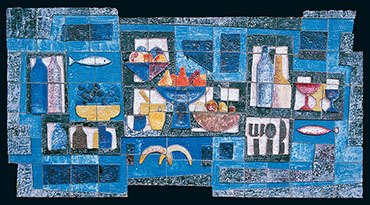Dactyloscopy
Ceramist, Árpád Csekovszky’s works in public places and civic buildings
What can be the possibilities of ceramics still hidden for modern architecture? Is it possible at all to produce new impressions, effects, shapes with one of the most ancient materials of architecture? It can only be measured in a period of thousands of years, the time since ceramics or pots have been used by builders – and it seems that after the wonderful Sumerian tile coverings, Etruscan ornamental mouldings or the Robbias’ terracotta decorations this artistic form is hardly able to give anything new. Yet, in our days, in the world of steel-glass, concrete, bronze, aluminium and plastic, instead of being pushed into the background besides other materials, the use of ceramics-matereials renews and it keeps becoming more significant than ever. In addition to brick cover and mettlachi mosaics, glazed faience and china covers, raw chamotte or silky ceramics surfaces appear quite often in various cultures and areas. Architectural ceramics can line up to the different functional purposes – from the mechanical protection of wall or pillar surfaces to the acoustics, or even to the different spiritual – psychological functions. In addition to functional reasons, the use of ceramics in modern architecture is strengthened by an internal harmony.
All the things said above were brought out by Ferenc Vámossy at an exhibition-opening (young ceramists’ architectural ceramics and friezes) held in 1970 at the head office of the Union of Hungarian Architects. The ceramists of the 50s and 60s without doubt were inspired by those large scale works, which were made by the great generation of ceramics such as István Gádor, Géza Gorka and Margit Kovács, the great triad by investigating new fields established new artistic forms.
In the earlier works of the three great artists, who created the standard works of modern Hungarian ceramics, ceramics sculptures connected with architecture and other different form of sculptures are not presented yet. It was not until the second half of the 1950s that the artists, who started their career at the turn of the 1950s, József Garányi, Viktor Janáky, Hédi Majoros, János Németh, Imre Schrammel, Ágoston Simó and József Simó and, in whose work Árpád Csekovszky’s oeuvre closely fits. Similarly to the above mentioned artists, Csekovszky’s works were made in the spirit of independent artistic program and by orders, connected to buildings and ceramics sculptures diplayed in outdoor or indoor public places and involving individual ceramics.
In the book published in 1979, the author could not report thoroughly about the artist’s monumental works ordered by the state, as these kinds of works were made later, in the 80s. With two works, In memory of the old town centre 1976 (stoneware relief) and the Open-air sculpture 1978 (glazed fired stoneware fountain) Csekovszky ended an era and Imre Katona described this period like this: ’Mr Csekovszky’s artistic work was making obvious progress. He is an experimental artist, however, he stayed within the boundaries of the artistic form’s strict rules. He is more interested in the plastic problems than that of the colourful decoration forming and influencing plasticity. Csekovszky was interested in spatial sculptures from the very beginning of his career. Although in the first years they did not bother him so much, later they got more and more into the centre of his interest. … Bear in mind that our first wall ceramics were picturelike, which were based on ready-made tiles.
Basically, this is how István Gádor and Margit Kovács also interpreted wall ceramics. Csekovszky and the new ceramist generation in general did not follow this method, they turned to the possibilities of plastic and glazed modelling instead, with which they could make walls and interiors look more exciting, dynamic and realistic in texture. This change was especially significant, because in Hungary ceramics had not been used in this way before. This procedure brought almost a new artistic form into existence, which attracted not only the architechts’ attention, but also those of building investors and others, who announced the competitions for such works.
Of course the solutions worked out experimentally on spatial sculptures were automatically applied to this artistic form. With the wall ceramics he had to struggle through to solve the problem, just like with open-air sculptures. Besides, there is that important circumstance that these artists following and integrating these traditions and producing pioneering works similarly to all artists of Hungarian art started their career after 1956 in a very frozen atmosphere, which was preceded with the voluntarist fifties pervaded with a rigid and dogmatic spirit so restricting the artist’s independence.
From the turn of the 1950s and 1960s Hungarian art work was under a very strong, forceful control by the government and the communist party. Everything seemed to be suspicious that was thought to be modern. No work could get into public until it was checked by a board. Those artists who served the socialist spirit were given an outstanding preference by the state, while others not taking an oath of allegiance to the political system with their works were not given the same treatment.
Though not declared directly, abstract art was forbidden. This policy was later accomplished with three slogans: support, tolerance and prohibition meaning the so-called three words in Hungarian all beginning with the letter T: that is Támogatás – support; Tűrés – tolerance and Tiltás – prohibition. From the mid 1950s the so-called two thousand, which was gained from projects financed by the state and had to be used for supporting works of art, was to inspire the artists to make monumental pieces. This gave the development of monumental sculptural works an incredible momentum, first of all plastic art undertaking the propagandastic role, but this practice consedirably helped the birth of monumental ceramics works. However, the minutes of the Arts Committee sitting from 1962 and carrying out the intellectual and professional control gave evidence of the fact that from the two thousandth funds no abstract sculpture, relief, wall-painting or mosaics could be fulfilled. On the other hand, it gave a rather free and more liberal approach to those ceramists who used larger space and, the works of whose were judged as a proper, acceptable activity while in terms of classification they were regarded as decorative elements.

The list of the monumental works was published in the book called Árpád Csekovszky, the ceramist’s collected works of art Edited by Mrs.Árpád Csekovszky, Balázs Csekovszky, 1997.
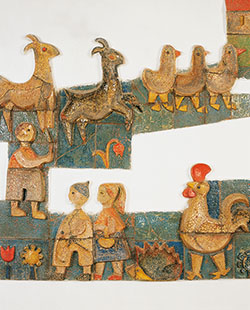
In the preface of the book, the artist, Árpád Csekovszky looks over his professional career but, interestingly though, he does not examine the monumental works in details. He observes these ceramics only in terms of procedure and the applied technique. He only mentions that ’ I tried to show my pupils different ways towards architectural and figurative ceramics by drawing attention to the architectural remains of ceramics, on their significance of place and time, in addition, where and when they were applied. For this complex work I invited architect lecturers and was also supported by the Department of Architecture.’
Most of the 25 works were made for buildings and only a few ones are individual ceramics. Their connection with architecture can also be observed as whether they are wall pictures or reliefs – there are more reliefs than ceramics wall compositions or ornamental wall tiles.
As for the time of their birth, after the first piece, which was made in 1958, he was given orders yearly or every other year, but after 1986 with one exception he did not make any large-scale sculpture. This fact was rather typical at that time: the resources were used up and the architectural demands had changed. With the spread of lightweight technologies, precast concrete and rooms without walls, the chances of ceramists for monumental orders were considerably reduced.
There is another interesting aspect to observe, that is after inaugurating how many of the wall ceramics and reliefs can be seen even today; which of them were destroyed because of the circumstances; or how their surroundings have changed.
Unfortunately, the glazed ceramics fountain (cylinder-column with a female figure holding a basket on her head) was put up at the entrance hall of the Agricultural Exhibition and Fair, Xth district, Budapest, but it got lost. The four interior column covers depicting the shape of a horse in EMKE Coffee House were destroyed when the buliding was renovated as well as were the column covers in the selling area of the department store in Debrecen. The frieze in Beremend (Vertical Rhythms) is considered to be among the greatest losses. He arranged a dynamically pervading space-rhythm with the edges sticking out from the surface sometimes with angle inclination and getting closer or further away from each other.
On the other hand, there are good examples, too. When, in 2001 the Regional and City Library in Kaposvár was rebuilt, the History of Writing wall tiles composition was carefully treated and preserved similarly to Radiation in the one-time Youth Camp in Salgóbánya.
The artist made a wall covering from glazed tiles for the walls of the Szentes Thermal Bath in 1963, but due to technological errors it got damaged. In 1989-90 Árpád Csekovszky redesigned it and made the tiles from glazed fired stoneware ceramics supported by Zsolnay Porcelain Factory, Pécs.
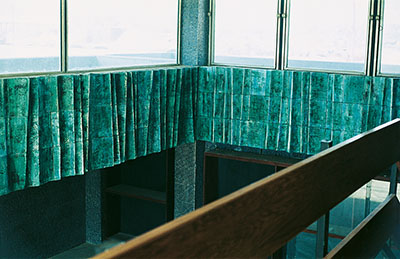
In terms of style and forms, all the remaining and destroyed works can be devided into two groups; the groups based on real motives and the other involving abstract compositions. Both groups include flat ceramics reliefs and ceramics sculptures. Of course these groups are not so fixed as we can find a few works which cannot be put in either category. Two really significant and monumental reliefs, The World of Cells and Dactyloscopy, which are microscopic pictures and the enlarged, almost abstract depiction of motifs of real things, can be found in Kazincbarcika.
To summarize, we can state that at the beginning of his oeuvre figural works were most typical made as statuettes, ceramics pictures or reliefs, while from the 1970s he was rather attracted to the abtstract order of forms, although he created some figural works in his studio by order.
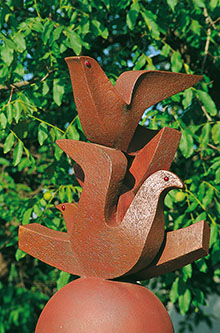
As I have already mentioned, the cylinder-column with a female figure holding a basket on her head at the entrance hall of the Agricultural Exhibition and Fair, was the very first Csekovszky sculpture put up in a public place. Another ceramics sculpture ’Charioteer’,1974, (stoneware coloured with oxide, Piroska Nursery’s garden, Budapest, XVIIth district)
shows a different artistic point of view. The charioteer motif is a constant source of inspiration through his oeuvre appearing on reliefs and on spatial compositions representing his affection for ancient cultures and arts such as Little Chariot 1960, Charioteer I. 1967, Charioteer II. 1970, People on the chariot 1971, Green charioteer 1971, Chariot 1982, but this motif can also bee found on the terracotta frieze (1970) of the studio houses in Hódmezővásárhely. János Frank, the art historian said the followings in an interview made with Árpád Csekovszky published in Élet és Irodalom, 1968 Frank, J. ’A visit with Árpád Csekovszky’s.’ Élet és irodalom. March 3, 1968 and later in the book called ’Studios made to speak’ Budapest: Magvető Kiadó, 1975:228-231. :’Csekovszky models the Roman chariot in a moderate style. Sometimes he is repetitive placing several horses, chariots, charioteers and and so the group is a homogeneous composition , a system of chariots. Owing to it, the sculptures are made of ceramics with glaze or just very little oxide or colour as if they were discoloured archeological findings.’
The unglazed terracotta sculpture, which is in the nursery’s garden placed on a stone pedestal and consisting of three horses, three standing, puppet-like figures and the wheel disks, is a playful and rythmical picture. When seen from different directions, the sculpture seems to be varied and and it shows new details due to the horses and the figures put in a complicated spatial structure. The period of figure compositions ended in 1986 with two minor works: Fountain with owl made for the Tihany resort village park and Doves (both fired stoneware) put up in the garden of the Centre of Family and Social Events, Budapest XVIIth district. Both sculptures are charachterized with the puritan design and the animals are almost reduced to the geometric order of forms.
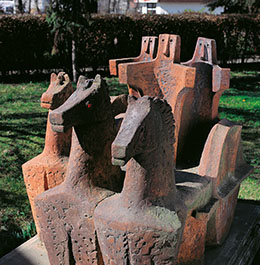
After examining the figure sculptures made in 1958, 1974 and 1986, it is interesting to observe the abstract compositions made in 1974 and 1978: Rhythm – stoneware coloured with oxide put up in the Government Holiday resort, Balatonszemes and the Open-air sculpture – glazed fired stoneware fountain in the park, Pesti út 167, XVIIth district of Budapest. The nature and the modelling were both determined by the task, function, the conditions of the place and the surroundings. It is worth mentioning that these two works can be classified as the rare pieces made by order to public places as non-figurative compositions.
Rhythm alike most Csekovszky’s works is an unglazed fired stoneware sculpture, which is made up of five geometric sharply edged prism crossings laid on each other on a vertical axis.
The statement by Imre Katona applies to both Rhythm and Open-air sculpture: the various accomplishments also occupy him within the structure, which is represented in the pyramid- like and vertical structures, especially the positive – negative geometric order and the assemble on each other. Depiction turns into rhythm.. here we get again to the same aspect of composition as we did with the chariot, man, horse and wheel, but in an abstract manner. The elements of the unglazed fired stoneware Open-air sculpture put in a little pool are laid on each other on a vertical axis. The elements are standing full prisms or prisms broken through in the middle that is either fitted straight to the other element on the levels or they are turned perpendicular to the others. The whole composition is finished with three circle-elements on top. In this composition the repetitive, changing elements in addition to the open space by the break-through and the closing space with the covering makes an exciting composition which is in harmony with the place and suitable to it.
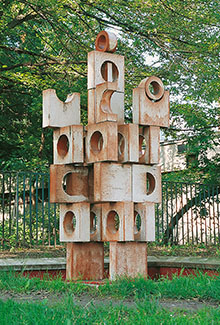
Csekovszky’s spatial works are even more significant than the ones connected to architecture. Besides six ceramics sculptures, we can find nineteen reliefs. In our observation first we are going to see the figurative, then the abstract pieces.
The figurative compositions include tile coverings, glazed and unglazed ones, deep and high ceramics and terracotta reliefs. The first large-scale relief, The Symbol of Trade made by order was in the selling area of the Centrum Department Store, Debrecen.
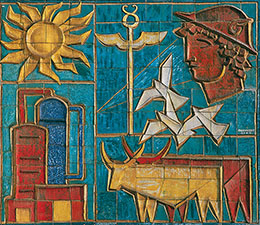
This composition, which is square shaped with the motifs one next to the other, is the example of the collage technique first used here. With the same emblematic function two judicial ceramics reliefs were made – the Seal in Baja (glazed ceramics relief, entrance hall of the Town Law Court , Baja) and the Code of Law (glazed ceramics relief, entrance hall of the Town Law Court, Siófok).
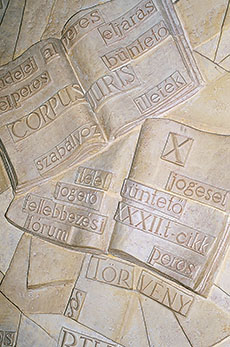
The two similar-sized ceramics reliefs were composed with the use of the section mark, the seal and the law-book in addition to the scraps of words and texts in 1981.
In terms of primary functionality we have to mention the great composition called National flags (glazed ceramics relief, Népstadion Gymnasium, Budapest).
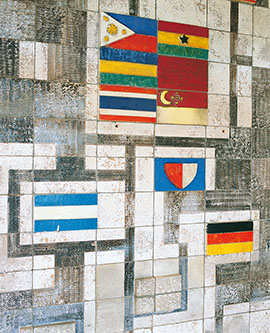
Here we can see the glazed tile covering with the sticking out flag patches on a greyish-brownish geometrically devided surface.
The most important collage-like relief is the History of writing, 1963 (glazed tiled wall with carved design, Auditorium of the the Regional and City Library, Kaposvár).
On the wall, which is made up of rectangular tiles in the shade of grey-blue composed on the contrast of the dark and light shades, human figures, buildings, symbols depicting culture and arts (the nucleus, the star, the lute and the mask) are outlined among the various letters, numbers, languages and extracts. This was the first work, in which the central construction appeared with the tea-light in the middle and the beam of rays radiant from it cover the whole surface. Some later works were based on this principle.
Still in the same year as the one in Kaposvár, the 270 square meter special wall covering as a
tile picture was completed on the huge wall of the Thermal Bath of Szentes. On the walls of the block without doors and windows the sometimes broken wall-face at the snipped corners and geometric patches of different shades are enlivened with the vertical and horizontal rectangular shapes rising from the surface, and the carves depict stylized animals and accidentally outlined motifs. Unfortunately, due to technological errors, the wall covering was damaged and later destroyed. In 1989-90 the artist designed a new covering.

This time he designed and composed an entirely geometric, decorative composition of the succession of diamonds and triangles truncated at the top which are laid on the horizontal stripes. The glazed fired stoneware tiles were made in Zsolnay Porcelain Factory in four colours - black, grey, yellow and white.
Another relief called Zodiac applying pictorialism, plasticity, outlines and paint patches was made for Hotel Karancs, a building of great project by the state of that time.
In 1964 in the upstairs hall as the continuation of the stairs, different sized zodiacs were put on a tile-covered wall arranged in groups creating changeable rhythms. Their role was to break up the rather cold, monotoneous interior of the hall and to fill it with bright colours and various forms.
In terms of conception and composition, the little smaller than three square meters glazed ceramics relief Little Animals, which is in the shades of blue and yellow and which depicts stylized animals on the facade of the City Hospital, Mór, tightly relates to the relief-series of Salgótarján.
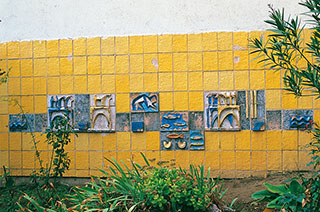
Another member of this series is the Relief put up in the shop floor and canteen at the Technical University of Heavy-industry, Miskolc in 1965. This work was made up of figurative motifs clearly outlined, deepened in and heightened from the surface in a rhythmical way and decorated with colourful glazes. On this relief the pictures are not isolated from one another but they make an overall and homogeneous composition. There are shapes, objects, instruments, tools, food and drinks all next to the other based on the relating motives, wallowing in an almost baroque style. This large-scale composition unites painting and sculptural elements in harmony and makes most of the opportunities of ceramics.
I will finish the overview of the glazed figurative ceramics reliefs with two epic pieces. The first is the Fairy-tale characters (glazed ceramics relief, corridor of the Public Health Chidren’s Home, Szombathely). The march of the animals and human figures is marked with irregular lines and it comes to life in a fairy-tale scene. The other work comprising four large-scale pieces called Fairy-tale castle, Fairy-tale boat, Fairy-tale house and Fairy-tale train (glazed ceramics reliefs, Összefogás Nursery’s entrance hall, Budapest XVIIth district) with its rich plasticity and the usage of motives, graceful and playful atmosphere has become an important, epoch-making and essential piece of the artist’s oeuvre and the whole Hungarian ceramics art.
We have come to the last two significant terracotta reliefs connected to figurative works. We have to highlight the facade relief Figured frieze on the studio houses, which were planned by György Rácz in Hódmezővásárhely. During the process of making the frieze the art historian, János Frank said: ’The clay model of one frieze has been made.
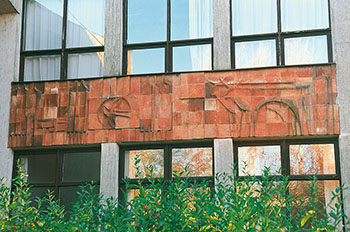
It is a rough, reddish, carved relief. It depicts the chariot but we can also figure out signs of the painter’s pictures as well as the dove-symbol. All of these are compacted, strictly tense and tectonic.’ (Frank, János. Studios made to speak. Budapest: Magvető Kiadó, 1975:230.)
The 36 square meter large, moderate terracotta frieze built between two rows of windows exactly represents Árpád Csekovszky’s creative ideas and artistic method, which he described in the catalogue of his oeuvre:’ The material of the ceramics made for buildings is fire-clay without glazing baked in a naked flamed kiln. For firing I used wood to stand out the natural colour of the clay and the power of the flame and fire. By this the surface of the forms became effective. I like this technique of firing even today and that is why I prefer terracotta. Fired clay denotes the natural beauty of primary modelling.’(Ceramist, Csekovszky, Árpád, Budapest 1997:41)
This beauty is unfolded on the ‘In memory of the old town centre, 1976 (stoneware relief) 60 square meter large relief.
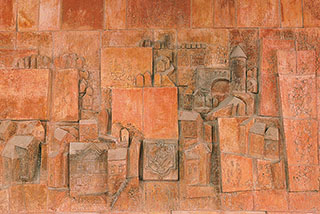
This work can be found under the archway of a tower block in the centre of Veszprém (middle-west of Hungary, Transdanubia). On the wall at right angles under the archway appears the townscape in two parts, which includes and highlights real and imaginary towndetails, houses and churches, geometric elements and coat of arms, playfully and closely arranged flat surfaces, where sometimes the richness of details or the delicate moulding is emphasised. This relief makes the fullest use of reliefs: the diagonals joining the rows of houses, the masterly depicted and moulded perspective shortenings, the elements turning out from the surface due to the tilt from time to time, as well as the light-shadow effects and the piling up crowds in Árpád Csekovszky’s interpretation make the old baroque small town come to life looking like almost a sculpture separated from the surface.
The last monumental group of works in Árpád Csekovszky’s oeuvre is the sculpturesque, abstract relief which involves four large-scale works of art. Two of them decorate the interior of the hospital in Kazincbarcika - The world of cells (glazed ceramics relief, upstairs hall of the City Hospital) - planned by György Jánossy, while the other two were realized in Beremend - Vertical rhythms (glazed ceramics frieze, relief, Office building of the cement-works) and in the Youth Camp, Salgóbánya. As I mentioned above, unfortunately the glazed relief put up in the office buliding of the cement works in Beremend, which was composed from the fading colours of bluish-greenish, turquoise, white and black, and with a rough surface and a rhythmic, systematic pattern was destroyed, so today we can only find three abstract reliefs in the original.
However, as for Árpád Csekovszky, we have to be careful with the word abstract, because he felt great affection for reality, the history of art, the memories, remains and motives. In the interview made by János Frank this is how the ceramist described The world of cells under process at that time: ’It is 20 square meters and it may seem to be abstract, but it is absolutely realistic and as this relief is going to be placed in a hospital, it is a representation of the nature of the place. It is the cellcuts and biology that inspired me, that’s what I am trying to mould in a plastic and colourful way.

On the 21 square meter glazed relief with arched lines, elliptic motives and slashed with crater like hollows, the greyish and bluish and the shades of glittering pearly colours are domineering.
In contradiction to The world of cells, which is the complicated order of composition, the system of fantastic world of organism invisible to the naked eye, the other work of central construction called Dactyloscopy in Kazincbarcika is more clearly perceivable. In the middle of the monochrome white-glazed relief there is a piece of glass, around which we can find an elliptic, enlarged fingerprint depiction. In his book Ákos Koczogh, who looked over Hungarian ceramics art said about Árpád Csekovszky, ’The compact, closed composition, the form simplified to the utmost, the sculptural subject search free from lyric is all exemplary for the generations succeding him, and it is not unusal among his contemporaries including sculptors either. Our first sculptor-architect ceramist is Árpád Csekovszky. … He is the master of inner dimension and positive-negative construction.’ (Koczogh, Á. Contemporary Hungarian arts and crafts.Ceramics, china, glassware. Budapest, 1975:23.)
Radiation, which is the abstract relief in the Youth Camp, Salgóbánya, is a central construction similar to the History of Writing, Kaposvár and Dactyloscopy, Kazincbarcika. The 21 square meters relief is a bit raised from the central point and moved to the left, and looks as if it was moving to the left from the centre. As a result of this, the slightly curved circles, flat surfaces ending with a corner drift away outward spirally and, owing to the spatial moving create a dynamic, waving relief surface. This large-scale composition made in 1979 is full of power, movement and rhythm.

From all that has been said above it must be clear that among Árpád Csekovszky’s works – whether monumental, made by order or set up in public places – it is quite hard systematize: His oeuvre was directed with versatile interest. He was an artist, who considered the legitimacy and possibilities of the material and technique but always investigated new solutions, and had the attitude to new questions and problems. However, he could adjust to the requirements made by order, and with each work the maximum artistic possibilities and the attitude searching for independence dominated. The apparent stylistic flights, the antique, Etruscan art and the numerous compositions all undertook and represented that he carried on the remains of the antique – Etruscan art. The disappearing and turning up again figurative order of forms, the completion of different compositions, the organic-abstract, and the almost rigid geometric order of forms all represent an investigating intellectual art, where in the deep, the XXth century’s artist’s strict moral and the extraordinary demand and quality element dominated.
In his study written after the artist’s death, Imre Schrammel wrote about Árpád Csekovszky’s monumental works connected to buildings ’… he was a determinant character of the development of Hungarian reliefs related to buildings. Perhaps if we get over this present shocking period, researchers will deal with this subject and then these important works in Csekovszky’s oeuvre will be put in their place. Not much time has passed since his death and, to be honest, I am partial, yet, I run the risk of stating that Csekovszky’s greatest credit is that from the world of patterned, and later divided architectural ceramics he was able to move to the range of built relief sculptures.’ (Schrammel, Imre: Csekó. Csekovszky Árpád 1931-1997. Magyar Iparművészet Volume 3.1997:16-19.).
Árpád Csekovszky by establishing his new artistic form and with his monumental works of art has left his mark on Hungarian ceramics art of the second part of the XXth century. His innovative intellectual personality opposing the atmosphere of the age false and insincere, his modern artistic concepts and his strict morals give evidence for the wide range of series of monumental works, all of which are kept alive by his students.
